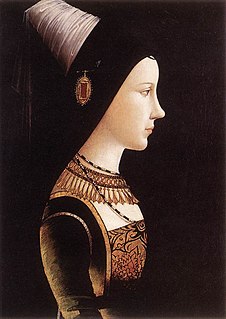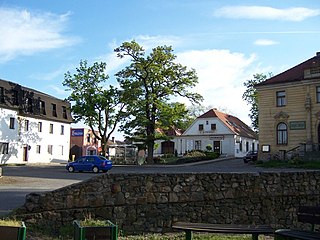
Beatrix of the Netherlands is a member of the Dutch royal family who reigned as Queen of the Netherlands from 30 April 1980 until her abdication on 30 April 2013.

Christian II was a Scandinavian monarch under the Kalmar Union. He reigned as King of Denmark and Norway from 1513 until 1523 and of Sweden from 1520 until 1521. From 1513 to 1523, he was concurrently Duke of Schleswig and Holstein in joint rule with his uncle Frederick.

Mary, Duchess of Burgundy, reigned over many of the territories of the Duchy of Burgundy, now mainly in France and the Low Countries, from 1477 until her death. As the only child of Charles the Bold, Duke of Burgundy, and his wife Isabella of Bourbon, she inherited the duchy upon the death of her father in the Battle of Nancy on 5 January 1477. Owing to the great prosperity of many of her territories, Mary was often referred to as Mary the Rich.
A queen consort is the wife of a reigning king. A queen consort usually shares her husband's social rank and status. She holds the feminine equivalent of the king's monarchical titles, but historically, she does not share the king's political and military powers. A queen regnant is a queen in her own right with all the powers of a monarch, who (usually) has become queen by inheriting the throne upon the death of the previous monarch.

Burgrave also rendered as Burggrave, was since the medieval period in Europe the official title for the ruler of a castle, especially a royal or episcopal castle, and its territory called a Burgraviate or Burgravate. The burgrave was a "count" in rank equipped with judicial powers, under the direct authority of the Emperor or King, or of a territorial imperial state—a prince-bishop or territorial lord. The responsibilities were administrative, military and jurisdictional. A burgrave, who ruled over a substantially large territory, may also have possessed the regality of coinage, and could mint their own regional coins.

Isabella of Austria, also known as Elizabeth, Archduchess of Austria and Infanta of Castile and Aragon, was Queen of Denmark, Sweden and Norway as the wife of King Christian II. She was the daughter of King Philip I and Queen Joanna of Castile and the sister of Emperor Charles V. She was born at Brussels. She served as regent of Denmark in 1520.

Dorothea of Brandenburg was Queen consort of Denmark, Norway, and Sweden two times each by marriage to Christopher of Bavaria and Christian I of Denmark. She served as interim regent during the interregnum in 1448, and as regent in the absence of her second spouse during his reign.

Thérésa Cabarrus, Madame Tallien, was a Spanish-born French noble, salon holder and social figure during the Revolution. Later she became Princess of Chimay.

The House of Lobkowicz is a Czech noble family that dates back to the 14th century and is one of the oldest Bohemian noble families. The first Lobkowiczs were members of the gentry of north-eastern Bohemia in the late 14th century.

The Duchy of Cleves was a State of the Holy Roman Empire which emerged from the mediaeval Hettergau (de). It was situated in the northern Rhineland on both sides of the Lower Rhine, around its capital Cleves and the towns of Wesel, Kalkar, Xanten, Emmerich, Rees and Duisburg bordering the lands of the Prince-Bishopric of Münster in the east and the Duchy of Brabant in the west. Its history is closely related to that of its southern neighbours: the Duchies of Jülich and Berg, as well as Guelders and the Westphalian county of Mark. The Duchy was archaically known as Cleveland in English.

Drakensteyn Castle is a small castle at 8 Slotlaan in the hamlet of Lage Vuursche, in the municipality of Baarn, Netherlands. It is the private residence of Princess Beatrix of the Netherlands, the country's former Queen.
The Bulmer family were a noble family of Norman England, resident in Yorkshire. The family takes their name from Bulmer, North Yorkshire. The name Bulmer comes from English "Bull mere", a lake frequented by a bull, and is an Anglicised form of Gaelic "Búir na mara" from the Celtic tribe Brigantes during their occupation of the area. Ansketil de Bulmer was the first documented member of the Bulmer family who lived in the area in the twelfth century with the current spelling.

Lady Ingeborg Åkesdotter Tott or 'Ingeborg Aagesdotter of the Thott', in her lifetime called Ingeborg Åkesdotter or simply Fru Ingeborg, was a Swedish noble, the consort of the Swedish regent Sten Sture the elder. She was the fiefholder of Häme in Finland. She functioned as the de facto queen consort of Sweden for over three decades and participated in state affairs during the reign of her spouse.

Christina of Saxony, was Queen consort of Denmark, Norway, and Sweden. She was born a granddaughter of Frederick the Gentle of Saxony, and daughter of Ernest, Elector of Saxony and Elisabeth of Bavaria. She was the grandmother of Christina of Denmark through her son Christian II.

Éléonore Marie Desmier d'Olbreuse was the wife of George William, Duke of Brunswick-Lüneburg. She was Countess of Wilhelmsburg from 1674 and Duchess of Brunswick-Lüneburg from 1676. She was the mother of Sophia Dorothea of Celle, who was the wife of George I. Thus she is the maternal grandmother of George II

Isabel of Viseu (1459–1521) was a daughter of Infante Fernando, Duke of Viseu and his wife and cousin Infanta Beatrice, Duchess of Viseu. She was a member of the House of Aviz and later, House of Braganza.

Škvorec is a market town situated in the Prague-East District, within Central Bohemian Region of the Czech Republic. On 1 January 2017, the municipality had c. 1660 inhabitants. Part of the townlet is also Třebohostice village.

Maria Elisabeth of Austria was the sixth child and the third surviving daughter of Maria Theresa I, Holy Roman Empress and Francis of Lorraine. She was an abbess of the Convent for Noble Ladies in Innsbrück from 1780 until 1806.
Lady Kai (甲斐姫), speculated to have been born in 1572, was the daughter of Narita Ujinaga, retainer of the Later Hōjō clan in the Kantō region. She is known as the heroic woman who helped her father's resistance at Oshi Castle against Toyotomi Hideyoshi's army during the Siege of Odawara. After the war, she became one of the wives of Hideyoshi. She was known for her bravery and beauty. According to the chronicle of Narita clan, she was praised as "The most beautiful woman in east Japan".(東国無双の美人)

Jonkvrouw Karin Hildur "Kajsa" Ollongren is a Dutch-Swedish politician serving as second Deputy Prime Minister of the Netherlands and Minister of the Interior and Kingdom Relations in the Third Rutte cabinet since 26 October 2017. She is a member of the Democrats 66 (D66) party.

















